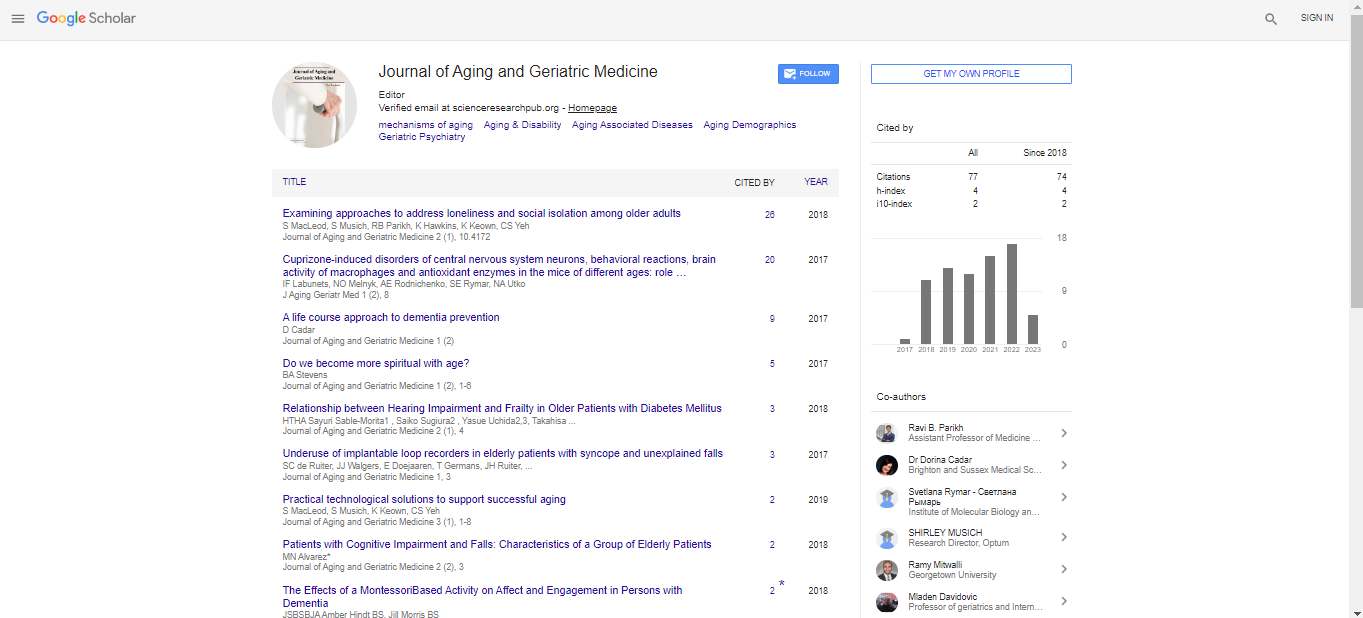Short Communication, J Aging Geriatr Med Vol: 7 Issue: 1
The Science of Aging: Understanding the Biological Processes of Growing Old
Sarah Edward*
1Department of Medicine, Weill Cornell Medicine, New York, USA
*Corresponding Author: Sarah Edward
Department of Medicine, Weill Cornell
Medicine, New York, USA
E-mail: edwardsarah@cornell.edu
Received date: 02 January, 2023, Manuscript no. AGM-23-95452;
Editor assigned date: 04 January, 2023, PreQC No. AGM-23-95452(PQ);
Reviewed date: 25 January, 2023, QC No. AGM-23-95452;
Revised date: 02 February, 2023, Manuscript No. AGM-23-95452(R);
Published date: 08 February, 2023, DOI:10.4172/2576-3946.1000149.
Citation: Edward S (2023) The Science of Aging: Understanding the Biological Processes of Growing Old. J Aging Geriatr Med 7:1.
Description
The science of aging is an interdisciplinary field that seeks to understand the biological processes of growing old. This field encompasses a wide range of disciplines, including biology, genetics, and medicine. While aging is a complex process that is still not fully understood, researchers have made significant strides in recent years in identifying the molecular mechanisms that contribute to aging and developing strategies to slow down or even reverse some of the agerelated changes [1].
One of the key processes that contribute to aging is cellular senescence. This refers to the phenomenon in which cells stop dividing and enter a state of growth arrest. While cellular senescence serves as a protective mechanism to prevent the proliferation of damaged cells that could lead to cancer, it also contributes to the aging process by reducing the regenerative capacity of tissues and organs. As we age, the number of senescent cells in our body’s increases, leading to a decline in tissue and organ function [2, 3].
Another important process that contributes to aging is the accumulation of cellular damage. This can occur through a variety of mechanisms, including exposure to environmental toxins, radiation, and oxidative stress. Over time, this damage can accumulate and lead to cellular dysfunction, which can in turn contribute to a wide range of age-related diseases, such as cancer, Alzheimer's disease, and cardiovascular disease [4].
While aging is a complex and multifactorial process, researchers have identified several key pathways and mechanisms that are involved in the process. For example, the mTOR pathway is a key regulator of cell growth and metabolism, and is thought to play a central role in aging. Researchers have found that by inhibiting this pathway, it is possible to extend lifespan and improve health span in a variety of organisms, from worms to mice to humans [5].
Another promising approach to slowing down the aging process is through the use of senolytic drugs, which selectively target and eliminate senescent cells. This approach has been shown to improve tissue and organ function, reduce inflammation, and extend lifespan in a variety of animal models [6, 7].
In addition to these approaches, there is growing interest in the use of stem cells for the treatment of age-related diseases. Stem cells have the ability to differentiate into a variety of cell types, and can therefore be used to regenerate damaged tissues and organs. While stem cell therapies are still in their infancy, they hold great potential for the treatment of a wide range of age-related diseases [8-10].
Conclusion
In conclusion, the science of aging is a rapidly advancing field that holds great potential for improving health and extending lifespan. While aging is a complex process that is influenced by a variety of factors, including genetics, lifestyle, and environmental factors, researchers have made significant progress in identifying key mechanisms that contribute to aging and developing strategies to slow down or even reverse some of the age-related changes. These include targeting the mTOR pathway, eliminating senescent cells, and using stem cell therapies to regenerate damaged tissues and organs. With continued research and development, it is possible that we may one day be able to significantly extend lifespan and improve healthspan, enabling us to live longer, healthier lives.
References
- Baumann K (2016) The yin and yang of mitochondrial dysfunction. Nat Rev Mol Cell Biol 17:331-332.
- Bentov, Y., Casper, R.F (2013) The aging oocyte—can mitochon-drial function be improved?. Fertil Steril 99:18–22.
- Bentov Y, Yavorska T, Esfandiari N, Jurisicova A, Casper RF (2011) The contribution of mitochondrial function to reproductive aging. J Assist Reprod Genet 28:773-783.
- Benzies K, Tough S, Tofflemire K, Frick C, Faber A, et al (2006) Factors influencing women’s decisions about timing of motherhood. J Obstet Gynecol Neonatal Nurs 35:625-633.
- Bharadwaj A (2007) Biosociality and biocrossings: Encounters with assisted conception and embryonic stem cells in India (1st edn). In Biosocialities. pp 108-126 Routledge
- Block E (1952) Quantitative morphological investigations of the follicular system in women. Acta Anat 14:108-23.
- Kim S, Parks CG, DeRoo LA, Chen H, Taylor JA, et al (2009) Obesity and weight gain in adulthood and telomere length. Cancer Epidemiol Biomarkers Prev 18:816-820.
- Zhang J, Cao X, Chen C, He L, Ren Z, et al (2022) Predictive utility of mortality by aging measures at different hierarchical levels and the response to modifiable life style factors: implications for geroprotective programs. Front Med (Lausanne) 9:831260.
- Stokes A, Collins JM, Grant BF, Scamuffa RF, Hsiao CW et al (2018) Obesity progression between young adulthood and midlife and incident diabetes: a retrospective cohort study of US adults. Diabetes Care 41:1025-1031.
- Newman AB, Lee JS, Visser M, Goodpaster BH, Kritchevsky SB, et al (2005) Weight change and the conservation of lean mass in old age: the Health, Aging and Body Composition Study. Am J Clin Nutr 82:872-878.
 Spanish
Spanish  Chinese
Chinese  Russian
Russian  German
German  French
French  Japanese
Japanese  Portuguese
Portuguese  Hindi
Hindi 